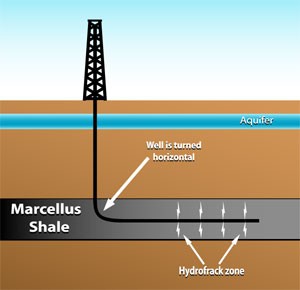Frick and Frack

By Sara Nedley
For many people in the U.S., hydraulic fracturing, or fracking, and its link to the natural gas industry has become a very important topic. Technological advancements have made access to pockets of natural gas contained in shale beds easier and therefore more profitable.
Fracking is a process used to inject fluids under high pressure into a well. By doing so, fractures are created in deep shale rock, enabling natural gas to escape. While fracking has been in use in the drilling industry since the 1940s, fracking combined with horizontal drilling has made extracting natural gas from shale easier. Horizontal drilling is a process by which wells are drilled first vertically, then horizontally for several thousand feet. On average, three to five times more natural gas is produced by horizontal drilling when compared to vertical drilling. Both the increased quantity and access equal increased revenue for the natural gas industry. The current boom in natural gas fracking can also be equated to availability of new jobs.
Despite the benefits, concerns over the environmental impact continue to cause debate. Environmental concerns include ground water contamination, decreasing air quality, potential migration of gases and fracking chemicals to the surface and mishandling of waste. There is also concern that the fracking process can cause small earth tremors. And despite natural gas being touted as a fuel that burns more cleanly, it is projected that 3.6-7.9 percent of methane produced by a well will be leaked into the atmosphere. Methane, a powerful greenhouse gas, and its leakage, means shale gas could be worse for the environment than coal or oil.
At the center of current debate in the U.S. is the Marcellus Shale, which covers approximately 90,000 square miles of West Virginia, Pennsylvania and New York. Between January and June 2011, Marcellus wells produced 432.5 billion cubic feet of natural gas.
In the fight to keep their backyards safe and clean, residents are leaning on lawmakers for their staunch support. Steps are being taken to ensure the safety and well-being of residents in this area. In Pennsylvania, gas wells cannot be drilled within 200 feet of structures, water wells or freshwater springs or within 100 feet of streams and wetlands.
Only time will tell the full story of fracking for natural gas, but in the meantime there are many facts and figures to be considered. To learn more about fracking, visit www.exploreshale.org for more information.
Classroom Discussion
- How did the Marcellus Shale form?
- What is a greenhouse gas and why is it bad for the environment?
- What other areas of the country are dealing with the issues related to hydraulic fracturing?